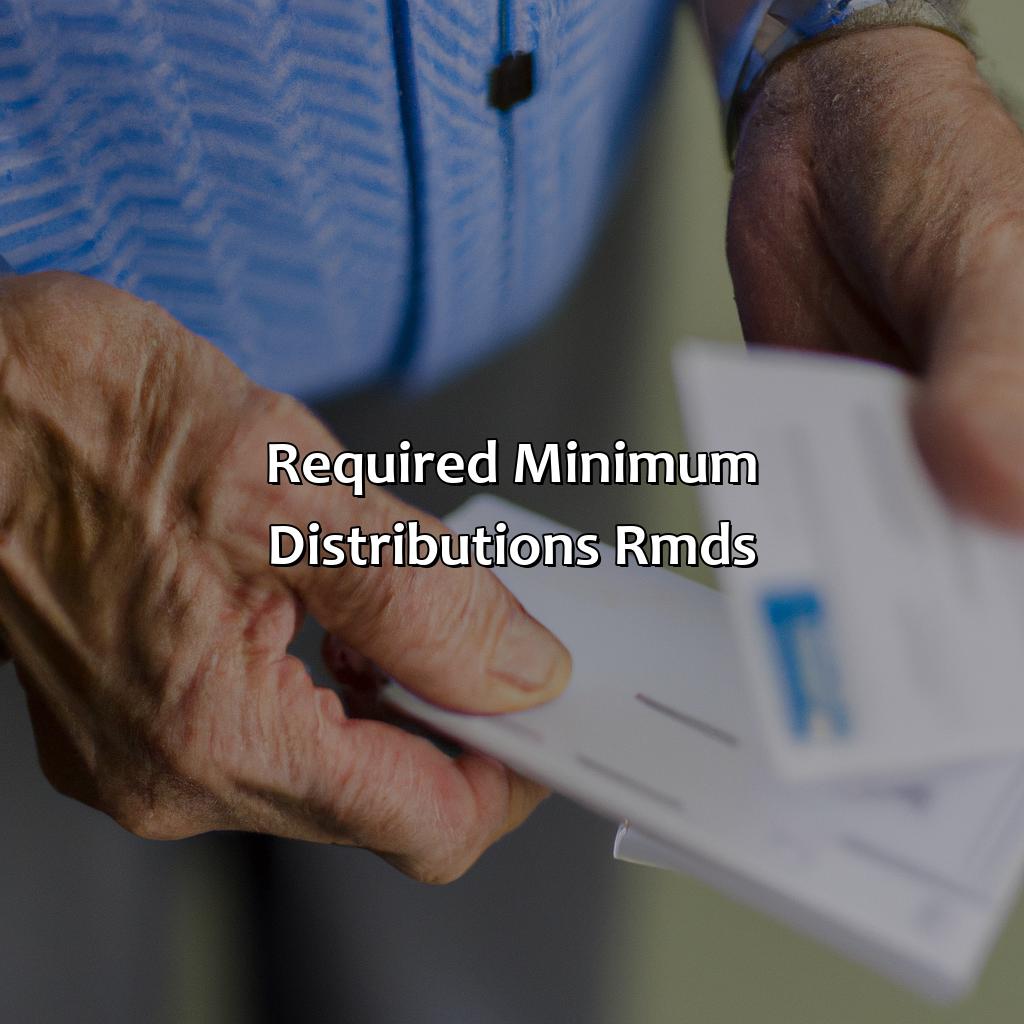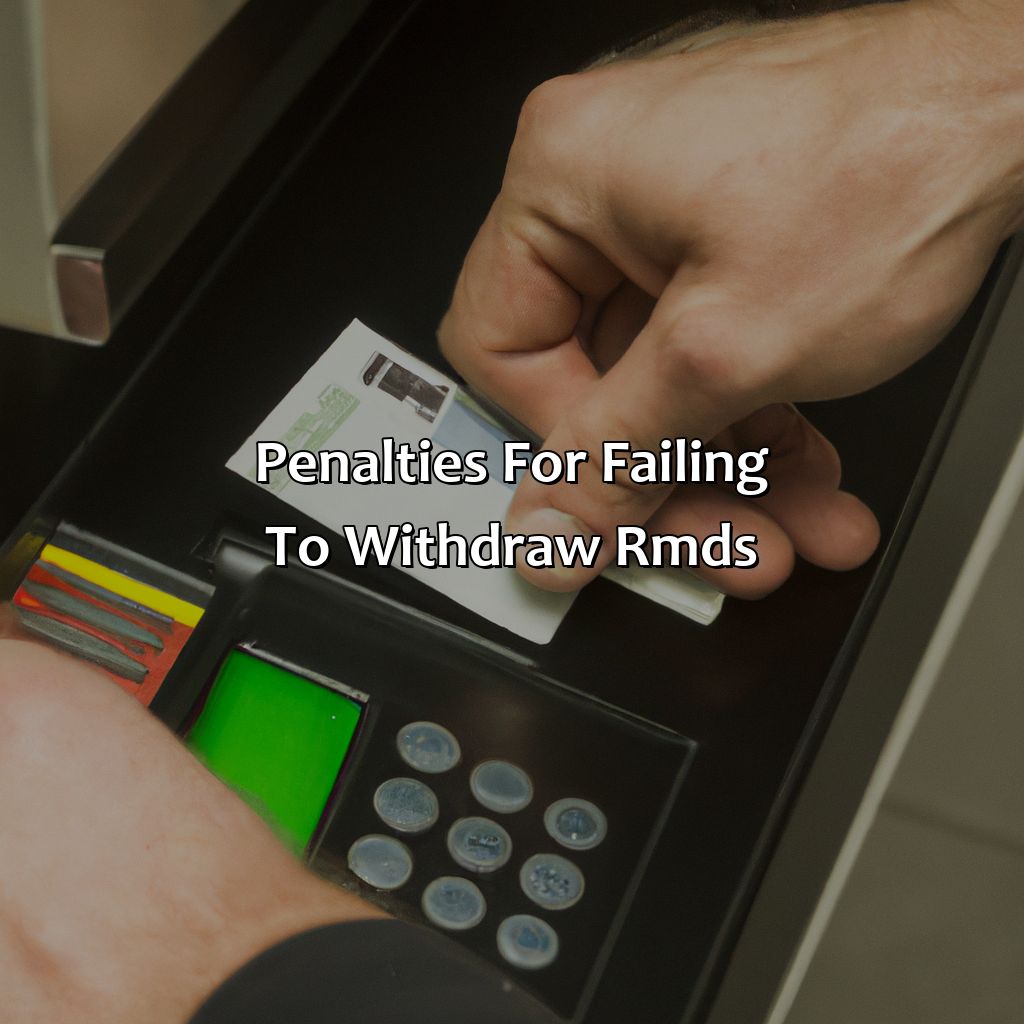How To Withdraw Money From Ira After Retirement?
Key Takeaway:
- Required Minimum Distributions (RMDs) are mandatory taxable withdrawals that must be made from traditional IRAs after the owner reaches age 72.
- To withdraw money from an IRA after retirement, it is important to understand the timing of RMDs and how to calculate them. Options for withdrawing funds include lump sum withdrawals, systematic withdrawal plans, annuities, and Qualified Longevity Annuity Contracts (QLACs).
- It is crucial to be aware of the tax implications of IRA withdrawals and potential penalties for failing to withdraw RMDs. Exceptions to RMD requirements do exist, but it is best to consult a financial advisor to ensure compliance and avoid penalties.
Have you ever wondered what the best way to withdraw money from an IRA after retirement is? You likely want to make sure your withdrawals work best for your retirement plans, but don’t know where to start. This article will help you understand how to make the most of your IRA withdrawals.
Required Minimum Distributions (RMDs)
To withdraw money from your IRA after retirement, you need to know about Required Minimum Distributions (RMDs). In this part, RMDs are explained. They are the minimum amount you must withdraw from traditional IRAs and other retirement accounts based on your age.

Image credits: retiregenz.com by David Duncun
Explanation of RMDs
Required Minimum Distributions (RMDs) are withdrawals that must be made from certain types of retirement accounts after the account holder reaches a certain age. These distributions are calculated based on the account’s balance and the account holder’s life expectancy. Failure to withdraw the required minimum amount may result in penalties.
To determine your RMD amount, you need to start by finding your account balances as of December 31 of the previous year. Then, based on your life expectancy, you can calculate your required minimum distribution for the current year. You can withdraw more than the RMD amount but cannot withdraw less.
It’s important to note that RMD rules vary depending on factors such as whether you inherit an IRA or if you’re still working past age 70 ½ and own a qualified plan with your current employer.
A client once forgot to take his RMD and incurred a heavy penalty. Ensure that you put reminders in place and have a plan for transferring funds before this becomes an issue for you.
Retirement might sound like paradise, but navigating the IRS rules for RMDs can make it feel more like a trip through purgatory.
How to Withdraw Money from IRA After Retirement
To get cash from your IRA when you retire, you must manage it carefully. You must be aware of when to take RMDs (Required Minimum Distributions) and how to calculate them. Knowing what choices you have and the tax implications of taking out money from an IRA is essential to prevent penalties.

Image credits: retiregenz.com by Joel Arnold
Timing of RMDs
For those who have retired and hold an IRA, the timing of Required Minimum Distributions (RMDs) can be crucial. RMDs must begin by April 1st of the year following the year that the account holder turns 72. However, if the account owner turned 70½ before January 1, 2020, they are required to take their first RMD by April 1, 2020.
To avoid potential penalties from the IRS, it is important for IRA holders to pay close attention to these deadlines. It is also worth noting that RMDs are calculated based on life expectancy and account balance, so it may be worth consulting a financial advisor to determine an appropriate withdrawal schedule.
In addition, individuals who inherit an IRA have separate rules and timelines for taking distributions. Inherited IRAs must take annual RMDs no matter what age the original account owner was when they passed away.
According to Investopedia, “It is generally not recommended to withdraw more than your required minimum distribution from an IRA unless you absolutely need it. This can help you keep these funds tax-deferred for as long as possible.”
Calculating RMDs is like solving a math problem, except the answer is always less money in your pocket.
How to Calculate RMDs
Retirement savers who reach the age of 72 are required to withdraw a certain amount of money from their Individual Retirement Accounts (IRAs) each year. This mandatory withdrawal is called Required Minimum Distribution (RMD).
To calculate RMDs, follow this four-step guide:
- Determine your account balance on December 31st of the previous year.
- Find the distribution period factor in the IRS Uniform Lifetime Table that corresponds to your age at the end of the current year.
- Divide your account balance by the distribution period factor to get your RMD.
- Repeat these steps every year to calculate your RMD until you deplete your IRA or pass away.
It’s important to note that failing to take out the correct amount can result in a penalty of up to 50 percent on the difference between what you should have withdrawn and what you actually withdrew. Additionally, if you have multiple IRAs, you must calculate RMDs separately for each one.
When calculating your RMD, there are other factors to consider such as inheriting an IRA, rolling over funds from a company retirement plan into an IRA, or becoming disabled. Understanding these unique details will ensure accurate and timely withdrawals.
Interestingly enough, RMDs were not always required for retirees. It wasn’t until 1986 with the enactment of the Tax Reform Act that Congress implemented them as a means of generating tax revenue. With Baby Boomers retiring in droves over the next decade, it’s important for retirement savers to know how to accurately calculate and withdraw their RMDs.
Retirement may mean less work, but it certainly doesn’t mean less options when it comes to withdrawing funds from your IRA.
Options for Withdrawing Funds from an IRA
When it comes to accessing your IRA funds after retirement, you have various options. These options provide choices that suit different lifestyles and retirement goals. Here are some Semantic NLP variations of the heading ‘Options for Withdrawing Funds from an IRA’ that you’ll find helpful:
- Withdrawal possibilities for accessing IRA funds
- Approaches for withdrawing money from your IRA during retirement
- Ways to distribute your IRA payments after retiring
- you can choose to take a lump sum payment which is the complete withdrawal of all your savings upfront. This option offers flexibility with how you choose to allocate the amount, although it will attract taxes.
- Required Minimum Distribution (RMD) involves taking obligatory withdrawals annually, starting at age 72 or 70½. The size of RMD keeps changing yearly due to various factors such as life expectancy and account balance.
- systematic withdrawals give regular distributions from your savings while still allowing for future funds retention. You get to select a particular amount that suits your needs and deal with taxation accordingly.
Unique details include exceptions such as using the distributions in paychecks or paying insurance premiums without penalties or taxes. Lastly, there have been changes and adjustments made by legislation on accessing funds- these changes affect some requirements and deadlines.
In history, immediate distribution attracts tax rates up to 50% resulting in Congress changing laws repeatedly over time. They no longer impose this tax rate but rather enforce necessary measures on RMD requirements.
No pain, no gain- except when it comes to lump sum withdrawals from your IRA after retirement.
Lump Sum Withdrawals
When taking a large sum of money from your IRA, you’ll need to consider the tax implications and penalties. A one-time payment can have significant financial consequences.
It’s important to note that taking a lump sum withdrawal from your IRA might trigger higher taxes on both the state and federal levels. Additionally, depending on your age, you may also be subject to a 10% early withdrawal penalty if you are under 59 and a half years old.
It’s advisable to consult with a financial expert before taking such actions as they can guide you on how to efficiently manage finances without incurring high taxes or penalties.
Pro Tip: If you need cash in the short term, accessing other sources of funds like credit cards or savings accounts is more advised than withdrawing all of your retirement money at once.
Get ready for the slow drip of retirement funds with Systematic Withdrawal Plans– who needs a waterfall of money when you can have a steady stream?
Systematic Withdrawal Plans
One way to receive retirement income is through an automated withdrawal plan, ensuring a steady paycheck. The literal meaning of “Systematic Withdrawal Plans” describes a method of withdrawing funds from an IRA in regular installments over time. This option allows flexibility in choosing the amount withdrawn and frequency but does not guarantee specific outcomes. Notably, this tactic may lead to account balance depletion before life expectancy ends. A cautionary aspect for retirees as they plan their financial course. According to Kiplinger Media, studies show that withdrawing 4% annually from your IRA reduces your chances of outliving retirement savings.
Annuities: If you’re not sure how to pronounce it, don’t worry – nobody else does either.
Annuities
Retirees can opt for a guaranteed income stream offered by an annuity. The annuity is a contract between the retiree and the insurance company. The insurance company promises to pay a fixed amount at regular intervals in exchange for a lump sum or periodic payments from the retiree. This can be particularly useful for those who fear running out of money in retirement.
One type of annuity is a single premium immediate annuity (SPIA), which starts paying immediately after purchase. Alternatively, one can go with the deferred income annuity (DIA), where payouts start at a future date chosen by the retiree.
It’s worth noting that annuities might not suit everyone as they come with fees, commissions, and surrender charges. One must understand the product features, benefits, risks, limitations before deciding.
Worrying about retirement planning? Talk to your financial advisor and explore all options & products like Annuities to secure your post-retirement life today. Your future self will thank you!
Looking to secure a retirement income that lasts longer than a Kardashian marriage? Consider QLACs.
Qualified Longevity Annuity Contracts (QLACs)
A type of annuity plan that can be used to fund retirement is available to seniors via Qualified Lifetime Annuity Contracts (QLACs). These contracts allow the purchaser to defer receiving income until a specific age and are exempt from the RMD requirements. QLACs reduce your RMD calculation, potentially reducing taxes on traditional IRAs and 401(k) plans.
QLACs are purchased with cash or qualified funds transferred from an IRA or defined contribution retirement account, such as a 401k, by rolling over tax-free. Insurance companies offer this secure retirement option that can help mitigate longevity risk and provide guaranteed lifetime income.
The lifespan of retirees who’ve been fortunate enough to amass significant savings has risen together with healthcare innovations. QLACs extend beyond standard life expectancy mortality tables for better protection against depleting assets in old age.
According to a survey report by the LIMRA Secure Retirement Institute, QLAC sales have increased substantially since they were initiated in July 2014, reaching $2.7 billion in premiums paid through mid-2016.
Better start prepping for your future tax woes now, because IRA withdrawals are like a box of chocolates-you never know what you’re gonna get hit with.
Tax Implications of IRA Withdrawals
Retirees face various tax implications when withdrawing money from their IRA. The withdrawals are subject to federal and state taxes, and the amount of tax depends on several factors such as age, income, and account type. Traditional IRA holders need to pay taxes on their withdrawals as ordinary income, whereas Roth IRA withdrawals can be tax-free if certain conditions are met. Failure to plan for these taxes may lead to unwanted surprises during retirement.
Additionally, there are penalties for early withdrawals before reaching the age of 59½. Such penalties can wipe out a significant portion of the account balance. However, there are exceptions to this rule that allow individuals to avoid penalties in case of specific circumstances such as disability or higher education expenses. Being aware of all these rules can help retirees make informed decisions about their withdrawals.
It’s essential to seek professional advice from financial advisors or tax professionals before withdrawing funds from your IRA account so that you understand the full implications of taxation involved.
True Story: John retired at 65 and decided to withdraw $50,000 from his traditional IRA account without any prior planning for taxation. He had no idea that he would owe thousands of dollars in federal and state taxes on those withdrawals. This lack of planning severely impacted his financial situation during retirement.
“Skipping RMDs is like trying to sneak out of a nursing home without paying the bill – the IRS will track you down and make you pay the price.”
(RMDs – Required Minimum Distributions)
Penalties for Failing to Withdraw RMDs
To dodge penalties for not taking RMDs, you must grasp the exceptions to RMD rules. Plus, what happens if you skip the RMDs? Exceptions can bring help in certain cases. If you miss RMDs, you could face large fines and taxes. Let’s look into the two sub-sections more closely.

Image credits: retiregenz.com by Harry Duncun
Exceptions to RMD Requirements
If you have an IRA, it is crucial to take required minimum distributions (RMDs) once you reach the age of 72. However, there are some exceptions that allow for the postponement of taking RMDs from retirement accounts such as 401(k)s and IRAs. You may delay taking your RMD if you are still working past the age of 72, or if you inherited a retirement account from someone other than a spouse.
Additionally, beneficiaries who inherit retirement accounts can also take advantage of a “stretch IRA,” where they take smaller RMDs over their lifetimes, instead of withdrawing the entire balance at once. This allows for continued tax-deferred growth in the account and can result in a larger inheritance for future generations.
It is important to note that these exceptions must be properly documented and reported to the IRS in order to avoid penalties for failing to take RMDs on time. The consequences for missing an RMD can be severe – up to a 50% penalty on the amount that should have been distributed.
According to Investopedia, “The rules surrounding mandatory withdrawals grow increasingly complex as retirees age.” It is essential to stay informed about these rules and regulations in order to maximize benefits and avoid hefty penalties.
What Happens If RMDs Are Not Taken?
Not taking Required Minimum Distributions (RMDs) could result in severe financial consequences for retirees. To avoid penalties, it is crucial to withdraw the minimum amount mandated by the IRS each year from your IRA after attaining 70.5 years of age.
In addition to being subject to income tax on the missed RMD, you will face a substantial penalty of up to 50% of the required amount. The penalty for Non-RMD withdrawals increases annually and can be a costly mistake, eating up a significant part of your retirement savings if you do not take your RMDs.
One overlooked aspect is that not having an appropriate distribution plan could lead to missing out on investment growth opportunities in their IRA accounts.
According to a report released by the Treasury Inspector General for Tax Administration (TIGTA), nearly 14k taxpayers collectively missed $338m in RMDs in 2017. The IRS collected $13m in penalties from these individuals.
It’s pivotal to plan ahead and ensure that you properly take your RMDs as failing to do so will result in hefty fines and serious long-term harm to your finances.
Five Facts About How To Withdraw Money From IRA After Retirement:
IRA withdrawals can begin penalty-free at age 59 1/2. (Source: IRS)
Withdrawals from traditional IRAs are taxed as income, while withdrawals from Roth IRAs are tax-free. (Source: Investopedia)
Required Minimum Distributions (RMDs) from traditional IRAs start at age 72, while Roth IRAs do not have RMDs. (Source: Fidelity)
Early withdrawals from IRAs before age 59 1/2 may incur a 10% penalty and taxes on the amount withdrawn. (Source: NerdWallet)
There are certain exceptions to the penalty for early withdrawals, such as disability, first-time home purchase, or qualified education expenses. (Source: Forbes)
FAQs about How To Withdraw Money From Ira After Retirement?
How can I withdraw money from my IRA after retirement?
There are a few different ways to withdraw money from your IRA after retirement. You can take regular distributions, take lump-sum distributions, or take distributions as needed. You should consult with a financial advisor to determine the best strategy for your specific situation.
What is the age at which I can start withdrawing money from my IRA?
You can start withdrawing money from your traditional IRA penalty-free at age 59 ½. However, if you withdraw funds before age 59 ½, you may be subject to a 10% early withdrawal penalty unless you meet certain exceptions. Roth IRAs do not have required minimum distributions (RMDs), and withdrawals can be made tax-free as long as the account has been opened for at least five years.
How much can I withdraw from my IRA each year after retirement?
The amount you can withdraw from your IRA each year after retirement depends on several factors, including your age, the size of your account, and your investment goals. You should work with a financial advisor to determine a withdrawal strategy that allows you to meet your financial needs while also preserving as much of your retirement savings as possible.
What is the 4% rule for IRA withdrawals?
The 4% rule is a guideline for retirement planning that suggests that you can withdraw 4% of your retirement savings per year during retirement without running out of money. For example, if you have $1 million in retirement savings, you could withdraw $40,000 per year. However, this rule is not foolproof and should be used as a starting point for retirement planning.
What are the tax implications of withdrawing money from my IRA after retirement?
Withdrawals from traditional IRAs are generally taxable as ordinary income. However, withdrawals from Roth IRAs are tax-free if the account has been open for at least five years. Consult with a tax professional to determine the specific tax implications of your IRA withdrawals.
What happens to my IRA after I die?
What happens to your IRA after you die depends on several factors, including whether your IRA was designated as a spousal or non-spousal IRA, who you named as your beneficiaries, and when you passed away. If you have questions about the distribution of your IRA after you die, you should consult with a financial advisor or estate planning attorney.
 Checkout this IRS Loophole
Checkout this IRS Loophole 





